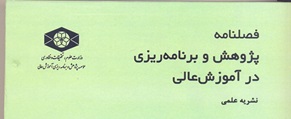عوامل مؤثر بر تقلب دانشجویان درآزمونهای دانشگاهی
نویسندگان
1 دکترای ترویج و آموزش کشاورزی دانشگاه تربیت مدرس، تهران، ایران
2 مدیر پژوهش دانشگاه آزاد اسلامی واحد علوم و تحقیقات گلستان، گلستان، ایران
3 استادیار گروه مدیریت کشاورزی دانشگاه آزاد اسلامی واحد مهاباد، مهاباد، ایران
چکیده
تقلب دانشجویان در آزمون یکی از مشکلات شایع در نظام آموزشعالی کشور است. بررسیها نشان میدهند که وضعیت تقلب علمی در کشور بسیار تکاندهنده است، بهطوریکه از مرحله آسیب خارج شده و به مرحله بحران رسیده است. هدف تحقیق حاضر شناسایی عوامل مؤثر بر تقلب دانشجویان در آزمونهای دانشگاهی بود. روش پژوهش از نوع توصیفی- همبستگی بود که به صورت پیمایشی انجام شد. جامعه آماری شامل کلیه دانشجویان دوره کارشناسی دانشکده کشاورزی دانشگاه آزاد اسلامی واحد گرگان بود که حداقل یک نیمسال تحصیلی را گذرانده بودند (401=N). از این میان، تعداد 196 نفر با استفاده از جدول کرجسی و مورگان به روش نمونهگیری تصادفی ساده بهعنوان نمونه آماری انتخاب شدند و در نهایت، 180 پرسشنامه جمعآوری شد (180=n). ابزار پژوهش پرسشنامهای ساختارمند حاوی سؤالهای بستهپاسخ بود که روایی و پایایی آن با پانل متخصصان و آزمون آلفای کرونباخ تأیید شد. از روشهای آمار توصیفی و غیرپارامتری برای تجزیه و تحلیل اطلاعات استفاده شد. نتایج توصیفی تحقیق نشان داد که اجازه به سایر دانشجویان برای دیدن برگه آزمون بدون تقلب خودم (%70/86)، رونویسی از پاسخهای دانشجویان کناری با هماهنگی آنان (%80) و استفاده از زبان ایما و اشاره به خصوص انگشتان برای شمارهها (%70) بیشترین میزان تقلب پاسخگویان در آزمونهای دانشگاهی است. نتایج حاصل از ضریب همبستگی نشان داد که بین متغیرهای جمعیت شناختی و روانشناختی پاسخگویان با میزان تقلب آنها در آزمونهای دانشگاهی رابطه معنادار وجود دارد. در آزمون رگرسیون چندگانه خطی متغیرهای نگرش به تقلب در آزمون، انگیزه برای تقلب در آزمون، سن و سنوات تحصیلی توانایی تبیین 39 درصد از تغییرات میزان تقلب پاسخگویان در آزمونهای دانشگاهی را دارا بودند.
کلیدواژهها
عنوان مقاله [English]
Effective factors on studentsâ cheatingbehaviors on exams: A case study of Gorgan Islamic Azad University
نویسندگان [English]
- Saied Fealy 1
- Saeid Safar Pour 2
- Solaiman RasouliAzar 3
1 Ph.D.in Agricultural Extension and Education, Agricultural College, Tarbiat Modares University, Tehran, Iran
2 Research Manager, Islamic Azad University, Science and Research Branch, Gorgan, Iran
3 Associate Professor, Department of Agricultural Management, Islamic Azad University, Mahabad Branch, Mahabad, Iran
چکیده [English]
Students’ cheating on exams is one of the common problems in higher education system in Iran. The investigations indicated that the condition of academic cheating in Iran has come to a crisis phase. The purpose of this study was to identify effective factors in Gorgan Islamic Azad University students’ cheating. The research method was descriptive-correlational survey. The target population included all bachelor’s students in Gorgan Islamic Azad University (N=401). By using simple sampling method and Krejcie & Morgan’s table, 196 people were selected and finally 180 filled questionnaires were collected. The research instrument was structural questionnaire with close-ended questions which its validity and reliability was confirmed by panel of experts and Cranach’ sapha test, respectively. Descriptive and nonparametric statistical methods were used to analyze information. The descriptive results showed that the main methods of respondents for cheating on exams were as follows: “permitting other students to see my paper” (86.70%), “coping fromother students’ exam sheet with their cooperation” (80%), and “using sign language especially fingers for correct choices” (70%). The results of correlation coefficient showed that there was a statistically significant relationship between respondents’ demographic and psychological variables with their cheating behaviors. The results of the bivariate regression revealed that 39 percent of variability in students’ cheating behavior stems from attitude toward cheating on exams, motivation for cheating on exams, age, and years at the university.
کلیدواژهها [English]
- Academic Cheating
- Cheating on Exam
- coping
- University
 فصلنامه پژوهش و برنامه ریزی در آموزش عالی
فصلنامه پژوهش و برنامه ریزی در آموزش عالی
